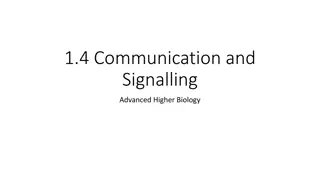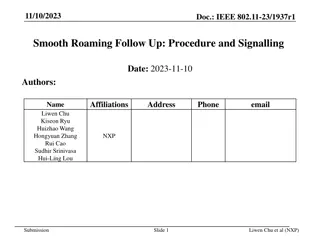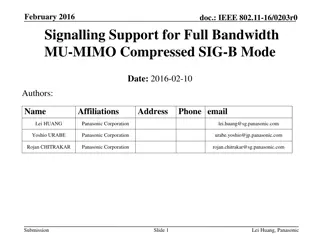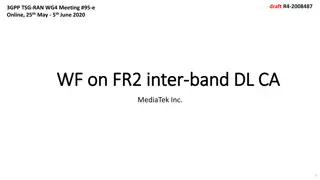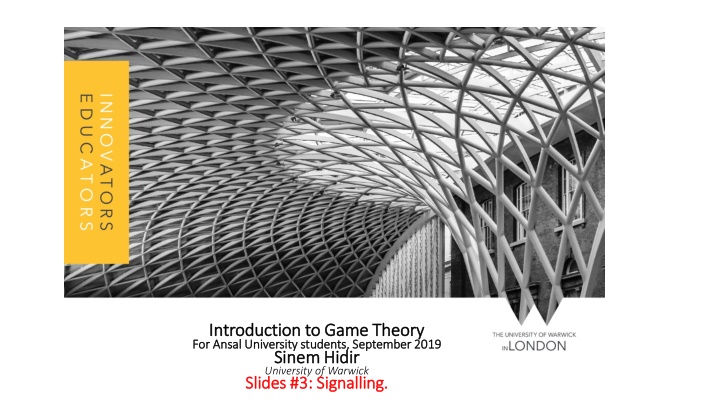
Signalling in Game Theory: Examples and Strategies" (55 characters)
Explore the concept of signalling in game theory, where individuals or entities convey private information indirectly. Learn how signals like warranties, education levels, and advertising can influence decision-making and establish credibility. Discover real-world examples and strategies, such as Hyundai's warranty improvements, to effectively communicate quality and intentions to consumers. Understand the importance of offering differentially costly signals to build trust and differentiate from competitors. (478 characters)
Download Presentation

Please find below an Image/Link to download the presentation.
The content on the website is provided AS IS for your information and personal use only. It may not be sold, licensed, or shared on other websites without obtaining consent from the author. If you encounter any issues during the download, it is possible that the publisher has removed the file from their server.
You are allowed to download the files provided on this website for personal or commercial use, subject to the condition that they are used lawfully. All files are the property of their respective owners.
The content on the website is provided AS IS for your information and personal use only. It may not be sold, licensed, or shared on other websites without obtaining consent from the author.
E N D
Presentation Transcript
Introduction to Game Theory Introduction to Game Theory For For Ansal Ansal University students, September 2019 University students, September 2019 Sinem Hidir Sinem Hidir University of Warwick Slides #3: Signalling. Slides #3: Signalling.
Signalling: Signalling: A signal is a way for a person, company or government to provide information about its privately known intentions or strengths indirectly. For a signal to be credible, we need that the cost of taking the action varies with the private characteristic of the informed party. 2
Examples: Examples: Education: salary varies with the amount of education, higher skilled agents get more education. Warranties: prices vary with the warranty offered and sellers of high quality products find it less costly to offer warranty. Advertising: mostly conveys no information other than that the firm can afford to advertise. Brands that advertise highly can charge higher! Companies paying dividends: dividends serve as a way of indicating positive future prospects. Entrepreneur seeking financing: choosing to retain equity ``put your money where your mouth is . 3
Peacocks tails, diamond engagement rings, tattoos of a partner, luxury items, being member of a club etc
Warranties as signals: Hyundai => in 1980 s, their cars weren t working well and quickly developed a bad reputation. 1990 s, Hyundai decided to improve, compete with other big companies => invest highly in quality, quality control, advanced factories.. However, consumers cannot really observe what is happening in the factories => asymmetric information.
How to convince the customers: a very comprehensive warranty. Why this worked? As cars did improve a lot in quality, wouldn t need to be fixed often. If the quality of cars were still bad, then it would be too costly to provide the comprehensive warranty. => A credible signal must be differentially costly!
A credible signal must be differentially costly As a good quality car is less likely to break, the warranty will be paid less often by a firm selling good quality car. Then, for the same price, the high quality firm can afford to offer a higher level of warranty! Hence, a good quality firm can separate itself by proposing a high enough warranty AND charge higher as a result!
``Pants lawsuit, Pearson vs. Chung Pearson allegedly left a pair of grey pants at the Custom Cleaners, D.C. owned by Chung family. When returned to him a few days later than the promised date, Pearson refused saying the pants were not his. After initially demanding $1000 in compensation, Pearson sued Custom Cleaners $67 million for discomfort, inconvenience, mental distress, and attorney's fees for representing himself, as a result of their failure, in Pearson's opinion, to live up to ``satisfaction guaranteed" and ``same day delivery promises.
Pearson never really got any compensation from the Chungs... However, citing a loss of revenue and emotional strain from the lawsuit, the Chungs announced they had closed and sold the dry cleaning shop. Take home message => only offer a satisfaction guarantee if you re confident enough in your business!
Spence (1973), ``Job Market Signaling Even though education may not have any tangible benefits at work, it signals relative quality. Candidates with higher degrees get higher wages regardless of the subject they studied. Example: studying art history, then work as a management consultant! Even though the study doesn t provide the skills needed in that job, the candidates with degrees get paid more. How? Explanation: getting a degree is more difficult for someone who is less smart and determined.
A numerical exercise: Firms want to pay the workers their expected productivity. Firms value workers identified as good at 2500, 40% of population. Firms value workers identified as bad at 1500, 60% of population. If firms can t identify the type of worker, they think the worker is an average worker, what would be the competitive wage?
Good workers=> would like to be identified. Bad workers => would like to be confused with good workers. How can a good worker credibly separate himself? One possibility is to get an MBA. For education to be a credible signal: it should be that bad workers can t get an MBA as it is too costly for them (here in terms of mental effort). Now, assume that cost of studying per year is 300 for good workers and 600 for bad workers.
This is a sequential move game with incomplete information There can be 3 different types of Perfect Bayesian Equilibria: 1. Separating 2. Pooling 3. Semi-separating (mixed) We will focus on pure strategies, so each type chooses a level of education with probability 1. (ignore semi-separating)
Separating PBE Separating equilibrium is one in which good and bad workers can be identified. Only high skilled workers get positive amount of education, call ? = ? and low skilled workers choose ? = 0, respectively the firms propose the wages corresponding to their productivity.
Candidate separating equilibrium: only good workers get an MBA that lasts 3 years, and the employers identify MBA s as good workers. Is this indeed an equilibrium? What is the wage for workers with MBA s and those with no MBA s in this equilibrium?
To verify an equilibrium: 1. Check: no type will mimic the other (deviate): Incentive compatibility. 2. Check: the employer s belief and wages are consistent with the equilibrium behaviour of the workers.
Incentive compatibility: The low type does not find it profitable to choose the education level of high types (and get their wage). The high type does not find it profitable to choose the education level of low types (and get their wage).
Good workers should happily self select into education and bad workers self select into no education, neither want to deviate. The employers infer the workers types from their education level and offer wages accordingly.
length of MBA: Could a shorter degree also be ok? If it took only 2 years to get an MBA? Or if it took only 1 year? Find the minimum years to prevent the bad workers from mimicking?
Pooling BPE Both types choose the same level of education: ?. Check there is a pooling equilibrium where ?=1. What is the wage to anyone with ?=1? What is the wage to anyone with ? < 1?
Problem of pooling: Degree inflation! If everyone gets an MBA, getting an MBA is no longer a credible signal If it is made very easy to get a degree, good workers find ways to separate themselves: invest into a second degree? In the end, we need degrees for anything: ``degree inflation the practice of preferring or requiring a degree for jobs that were traditionally held by middle-skilled workers.
The Spence model => pessimistic about education.. You dont learn. Productivity doesn t change, hence education is socially wasteful. ``Redistribution => good workers better off, bad workers worse off.. Although signals may seem wasteful, they help overcome adverse selection by improving information in the market and realise gains from trade!
In reality, degree isnt the only information available in the job market: 1. Daley and Green (2014) ``Signalling with grades 2. Allos-Ferrer and Prat (2012) ``Job market signalling and employer learning
``Market Signalling with Grades, Daley and Green (2014) In addition to education, firms also obtain a noisy grade as a result of some test passed by the employee. The test performance is directly related to ability and cannot be manipulated: high ability workers will do better. When this outside test becomes sufficiently informative, the high ability workers rely less on education as a way to signal.
Recently in the UK: grade inflation! 'Grade inflation' means 80% more top degree grades https://www.bbc.co.uk/news/education-48951653 What does it mean for the value of grades and employers ability to screen? => Is this a good or bad thing?
``Job Market Signalling and Employer Learning Allos-Ferrer and Prat (2012): When employers also learn about the worker s ability while on the job, the signal value of education per se is less important. Even if a bad worker could mimic a good worker by getting education, while on the job, his ability will eventually be revealed. Both type of workers will rely less on education as a signal.
Conclusions A signal is a costly action that may reveal the type of an informed agent. This is the case if the signalling action leads to a separation between the different types. For a signal to lead to separation between the types, it has to be differentially costly as a function of the underlying type.
Other references used in this lecture: https://www.hyundai.co.uk/misc-pages/5_year_warranty , Hyundai Warranty policy. http://caselaw.findlaw.com/dc-court-of-appeals/1339256.html , Pearson vs. Chung.


